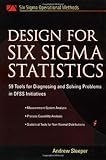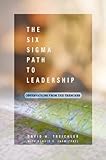Design for Six Sigma Statistics: 59 Tools for Diagnosing and Solving Problems in DFFS Initiatives Reviews
Design for Six Sigma Statistics: 59 Tools for Diagnosing and Solving Problems in DFFS Initiatives
In today’s competitive environment, companies can no longer produce goods and services that are merely good with low defect levels, they have to be near-perfect. Design for Six Sigma Statistics is a rigorous mathematical roadmap to help companies reach this goal. As the sixth book in the Six Sigma operations series, this comprehensive book goes beyond an introduction to the statistical tools and methods found in most books but contains expert case studies, equations and step by step MINTAB instruction for performing: DFSS Design of Experiments, Measuring Process Capability, Statistical Tolerancing in DFSS and DFSS Techniques within the Supply Chain for Improved Results. The aim is to help you better diagnosis and root out potential problems before your product or service is even launched.
List Price: $ 89.95
Price: $ 62.66
The Six Sigma Path to Leadership: Observations from the Trenches
Many organizations have seen dramatic improvements by implementing a Six Sigma system, including better efficiency, reduced errors, and increased profits. But for the individuals charged with implementing this system, it can be a long and arduous journey. The Six Sigma Path to Leadership: Observations from the Trenches was written to serve as a support guide for these individuals who may get lost or frustrated on their journey toward Six Sigma improvement. Author David Treichler has assembled a collection of stories showing how others handled these same situations, including the good and the bad with many how-to (and how-not-to) examples. The book is written for anyone – from senior management to the curious novice, with the intent to encourage and assist everyone, wherever they may be in their own Six Sigma journey. The Six Sigma Path to Leadership is not intended to teach the specific tools or techniques of Six Sigma, but rather to inspire and motivate Six Sigma professionals t
List Price: $ 63.00
Price: $ 21.67
Check This:
 The Lean Six Sigma Pocket Toolbook: A Quick Reference Guide to 100 Tools for Improving Quality and Speed
The Lean Six Sigma Pocket Toolbook: A Quick Reference Guide to 100 Tools for Improving Quality and SpeedA BUSINESSWEEK BESTSELLER Bestselling Lean Six Sigma author Michael George provides the first pocket guide for deployers of Lea…
 The Six Sigma Black Belt Handbook, Chapter 17: DMAIC Summary
The Six Sigma Black Belt Handbook, Chapter 17: DMAIC SummaryHere is a sample chapter from Six Sigma Black Belt Handbook, which offers the best and the latest information to assist you in s…
 The Six Sigma Handbook: The Complete Guide for Greenbelts, Blackbelts, and Managers at All Levels, Revised and Expanded Edition
The Six Sigma Handbook: The Complete Guide for Greenbelts, Blackbelts, and Managers at All Levels, Revised and Expanded EditionThe most comprehensive Six Sigma reference available, now revised and expanded. Completely rewritten and reorganized, this second…
Related Six Sigma Black Belt Products




Lets You Know What You’re In For.,
Reaching six sigma quality levels is not a simple tasks. Sure the results of improved quality levels are well known both in terms of increased customer satisfaction and overall lower costs. But six sigma ….
Both of these authors have a long history of working at the six sigma level. They’ve written this book not as a how-to, but as a report on their experiences in achieving six sigma.
First, it contains several reports of the “this is what we did and it worked,” type along with some “this is what we did and it crashed.”
Second this is a an alert to management to let them know what their committment has to be to enable a top-down alignment flow of understanding.
Because of their wide experience with six sigma, the authors know not only their own company (Raytheon) but have worked with other market leaders at companies such as GE, Delphy Automotive, Pratt and Whitney, Allied Signal and with consulting groups working in the quality area. They have talked with these other companies and report on some of the activities that have led them along the six sigma path.
This book can save a lot of heartaches in the implementation of working systems.
Was this review helpful to you?

|Well written, highly recommended,
I just got this on loan from my company library. I think I may have to pony up the cash up to put it in my personal library.
Right from the first few chapters, I knew I was going to love this book. Mr. Sleeper has an oustanding attention to detail. He even includes a chapter on how you should chart your data to better analyze it.
Even with the attention to detail, he writes in a precise manner. It just made sense more than any Six Sigma book I’ve read yet, and that is what matters. I just wish he published this book a long time ago.
Was this review helpful to you?

|The New “king of the hill in reference books”,
Well folks, clear off some space on your desk and make sure that space is right next to your PC as this is the new “king”.
As a Sr Engineer that has worked with suppliers for a number of years, this book is the new “one stop shop”. Andy proactively admits that this is an engineer’s guide first and math guide second, but his due diligence to the math is better than some “math” books on the topic. This is now the only book I keep at work. If more depth is needed, I bust out Montgomery’s DOE book or his SQC book. If more depth is needed in DFSS, I open Yang and El-Haik’s book. What most people miss is the overlap with tolerance analysis and to support this one, I turn to Creveling’s tolerance design book and for the Dim and Tol stuff I turn to Drakes book titled, Dim and Tol Handbook written by the best in class for each chapter.
Now, back to Mr. Sleeper’s work of magic. First, his examples are world class, well written, they flow, and when you read them, you can imagine yourself in that persons shoes. His humor is sprinkled just enough to peak a smile and the gem is left for last. If you have any of the other texts mentioned above, skip right to chapter 11 and watch the mystery unfold. Here Andy takes us down the path of true Design Simulation. Here we talk stackups, tolerances, cpks, six sigma expectations, DOEs, and Monte carlo. All design engineers out there need to buy this book and skip right to chapter 11 and for all those folks doing pure RSS stackups, you are being too optimistic on normality occurrences my friends. Read chapter 11 and see a safer time zero assumption. Normality is nice, but don’t assume it at time zero.
So, what should Mr. Sleeper write next: skip the quality tools Andy, all the old folks already write about them. Take us down the path of truly integrated design simulation. Tell the publisher you want a best in class bible on Design Simulation. To do this, follow Mr. Drake’s idea and let the content experts write a chapter. You have the vision, guide them…..Take chapter 11 and make it a separate textbook. Lets talk more about Monte carlo and the cross correlation pitfalls or not. Lets talk summarized research on best known dist for types of data, uniform, lognormal, etc. Then lets discuss the tweakable dist you stats geeks out there love to talk about and their pitfalls. I want to know more on truncated normals in @Risk and Crystalball, are they still normal then? We can also add the discussion on the hidden math that people never do….yeah the time zero partial diff to tell us what range to set the DOE +1 and -1 limits at.
So, to all you dorks like me that cant wait for books like this, here is the deal.
Content of this book. A- as depth can’t possibly be there on all topics. Flow of book and depth needed to get your job done A+. Style points and readability points, A+ Humor B+, the fact that the publisher was too na?ve to realize that a book this thick will never stay open when reading it, absolute F. Do your benchmarking you idiots. Oh that’s right they did, as they are the same ones that biffed up Yang and El-Haik’s book as well. It’s bad enough that they should reprint and make book larger. Book needs at least the size of Montgomery’s SQC book or Drakes Dim and Tol handbook.
So, content A, book size lending itself as a true handbook, F. No-one can give this thing a 5 star rating just on that fact alone. Andy, declare a “mis-print” and demand justice
Was this review helpful to you?

|